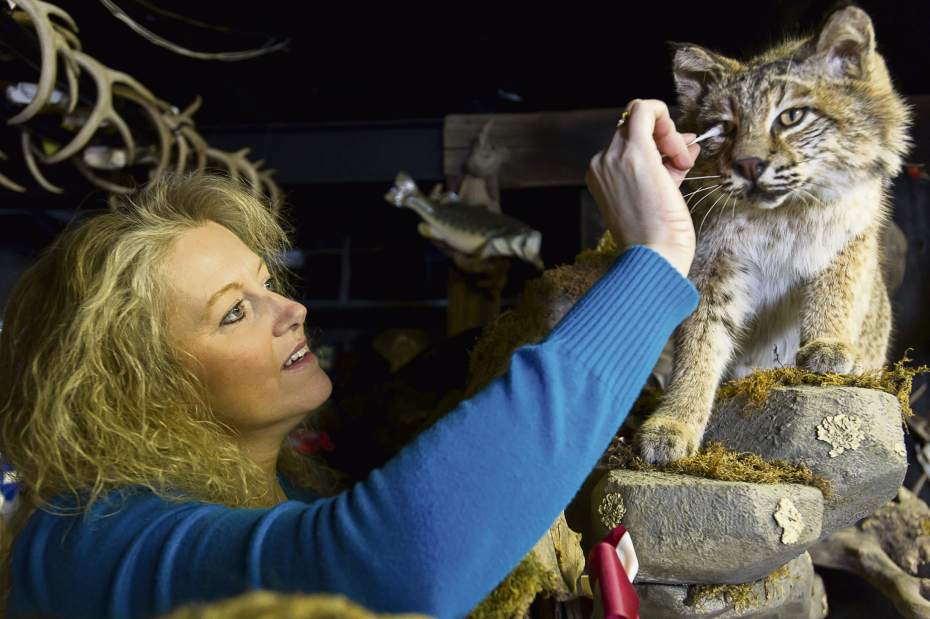Women turning to taxidermy in growing numbers
Jennifer LaRosa admits skinning season is not her favorite.
That's the month between the start of Pennsylvania's firearms bear and deer hunting and the time when the fleshing of hides in the family taxidermy shop comes — mercifully and never too soon — to an end.
Her husband Mike doesn't mind it nor does her 13-year-old daughter Bella.
But she's not a fan.
“That, to be truthful, is the hardest part for me. There's a yuck factor in getting those hides skinned out,” LaRosa said with a laugh.
“When the hides come back all tanned, they're leather, like a suede coat with fur. But before that, you wear rubber gloves, for sure.”
That's not kept her from being a taxidermist, though. Her husband started Mike's Taxidermy in Acme before they were married, but these days she does 80 percent of the mounts.
That puts her in select company.
There are 1,245 taxidermists licensed in Pennsylvania for the fiscal 2015-16 year, according to spokesman Logan Hall of the state Department of Agriculture, which issues the permits. It does not break down licensees by gender.
But Delores “Dee” Carley of Allegheny Taxidermy in Kane, membership secretary for the Pennsylvania Taxidermist Association, said it's believed only about 6 percent are women.
That number has been growing, however.
In 2005, for example, 5 percent of the Taxidermist Association's members were women, Carley said. Last year it was 9 percent.
The National Taxidermists Association was unable to provide figures on its membership. But Michelle Burkholder of Laurel Mountain Taxidermy in Mill Run, the group's current — and first woman — president, said the trend there is the same.
“There are an awful lot of women taxidermists anymore, some of them world renowned,” Burkholder said. “A lot of young girls are getting into it, too.”.
Most credit that to the growing presence of women in the outdoors in general.
A 2014 study done for the National Shooting Sports Foundation found, for example, that women represent the fastest-growing segment of the shooting industry. Another report, done by Southwick Associates, found women account for more than 25 percent of all anglers today.
“Look at your hunting apparel,” said Bob Hutchinson of Hutch's Taxidermy in Mt. Pleasant and president of the state taxidermist association. “Look at the clothes they have at Cabela's and Bass Pro and all of these shops. When my daughters started hunting I had to buy them men's boots. I had to buy them men's clothes. Now there's all kinds of stuff for them.
“I think that's why more and more women are getting into taxidermy, too.”
Many are drawn to it because of its opportunities to create, Burkholder said.
Years ago, taxidermy was little more than producing “creepy” stuffed heads, she noted. Today, they might mount a bear so that it's climbing on a rock or put a deer head on a fence post with leaves and barbed wire or have a bobcat on a log lunging for a fleeing chipmunk.
“It's really turned into an art form,” Burkholder said. “Especially when you see the work that's being presented at competitions and shows, it's more artwork than just a dead thing on the wall.”
That's what LeRosa likes about the business. She takes a hunter's animal and, with glass, foam, epoxy, glue and paint, creates something that stirs memories of his or her experience.
“It's taking all of these elements to recreate the beauty of nature,” she said. “That appeals to the artistic side of me.”
Few hunters have a problem with turning their deer or turkey over to a woman, said Lucinda Coll of Sacred Spirits Taxidermy Studio in Holbrook. There is often some initial confusion, though.
“Most everyone who walks in the door thinks it's my husband who's the taxidermist,” Coll said. “But no one's ever said anything or been awkward about it. Or if they have felt funny, they've kept it to themselves.”
“In the beginning I had plenty of hunters that were surprised that I was the taxidermist, but I don't think I have ever had a problem with hunters thinking that I couldn't do the job because I was a woman,” added Carley, who's known locally as “the woman taxidermist” in Kane.
There's nothing that makes men or women better or worse at taxidermy than the other, said Marc Jordan, a 24-year veteran of the business and operator of the Western Pennsylvania School of Taxidermy in Olivesburg.
He has been teaching students since 2003. Women are sometimes more patient and better at detail work because they have smaller hands, he said. But they are also sometimes behind in terms of the carpentry skills needed to build bases for mounts.
Professionalism and pride of work is what counts, he said, especially to the hunters waiting to get their trophy back.
“As long as they get a good job, that's all that matters to them,” Jordan said.
That doesn't mean guys sometimes don't just like talking to other guys, LaRosa said. Her husband and daughter hunt; she doesn't. So some who come in with something they want memorialized prefer to share their adventure with them.
“And I'm not offended by that,” she said. “It's like women who like to talk about shopping. Guys just don't get it. They don't understand the excitement of finding that perfect pair of shoes.”
So she talks to those who want to talk, and lets her husband chat with those who want a fellow hunter's ear. And she goes on with her work, turning wildlife into art.
And mentally prepping for the next skinning season.
“I'm a girly girl. I tell myself it's only a month, it's only a month,” she said. “Then the yuck is gone.”
Article by Bob Frye,
Everybody Adventures,
 http://www.everybodyadventures.com
http://www.everybodyadventures.com
Copyright © 535media, LLC

